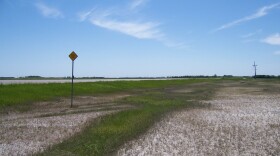
Chuck Lura has a broad knowledge of "Natural North Dakota"and loves sharing that knowledge with others. Since 2005, Chuck has written a weekly column, “Naturalist at Large,” for the Lake Metigoshe Mirror, and his “The Naturalist” columns appear in several other weekly North Dakota newspapers.
Lura was a long-time biology professor at Dakota College at Bottineau, publishing research on ecological aspects of grasslands in the northern Great Plains. In retirement, he continues to share his Natural North Dakota essays for the Prairie Public audience.
—
Natural North Dakota is supported by NDSU Central Grasslands Research Extension Center and Dakota College at Bottineau, and by the members of Prairie Public. Thanks to Sunny 101.9 in Bottineau for their recording services.
Hear Natural North Dakota on Prairie Public on Saturdays and Sundays at 8:35am CT.
-
No doubt many of you heard the recent news that “Wicked: For Good” star Jonathan Bailey was named People magazine’s Sexiest Man Alive for 2025. Okay... But what species would you select to be the most attractive small mammal in North Dakota?
-
Snowy owls, of course, are species of the tundra. So are lemmings, which are mouse-like mammals that are the main food source for snowy owls. For decades this predator/prey relationship has been known to be closely linked, and a four-year population cycle been well documented.
-
Turtle Mountain, straddling the Canada-United States border in Bottineau and Rolette counties, is often referred to as a “forested island in a grassland sea.” Because Turtle Mountain lies around 600-800 feet above the surrounding prairie, an orographic effect results in a notable increase in the effective precipitation on Turtle Mountain, resulting in conditions favorable to forest development.
-
November is here! We generally think of September, October, and November as fall — and with winter waiting in the wings, the animals have basically three options: migrate, hibernate, or stay and endure it. And the plants have no choice but to stay and endure the winter.
-
Several owl species nest in North Dakota, but their eerie calls and nighttime habits have inspired centuries of myths and legends — from wise protectors to harbingers of doom.
-
There is a new moon coming up on October 21, and you know what that means! It is prime time for some stargazing, plus there are a couple meteor showers putting on their annual show.
-
If you have been around the woods and thickets across the state over the past few weeks, a couple of interesting vines may have caught your attention. Neither species is well-known, but nonetheless, they put on an interesting show this time of year.
-
Most everyone in our region knows that the Red River forms a border between North Dakota and Minnesota. However, it might surprise you that the Red River does not delineate the entire eastern border.
-
A couple miles east of Bottineau, North Dakota, on the curve of Highway 5, there’s a sign in the ditch that says “quicksand.” It has been there for decades. I assume it’s a warning not to put your car in the ditch there. But if you do, particularly if you have been watching some old westerns on TV, don’t wait for the Lone Ranger to save you from quickly sinking into eternity. Actually, you probably wouldn’t need him anyway.
-
The autumnal equinox is on September 21 this year. Of course, when fall rolls around in North Dakota, the thoughts of birds migrating — particularly waterfowl — often come to mind.










